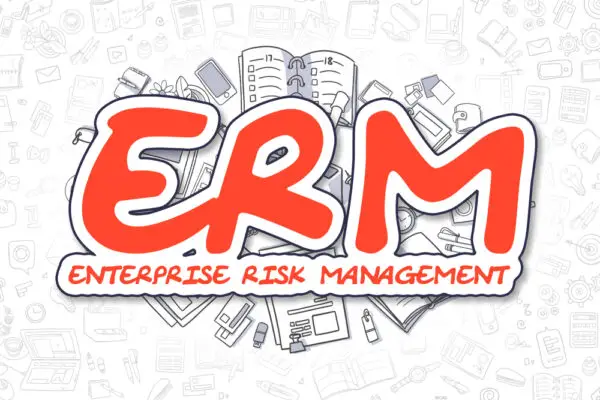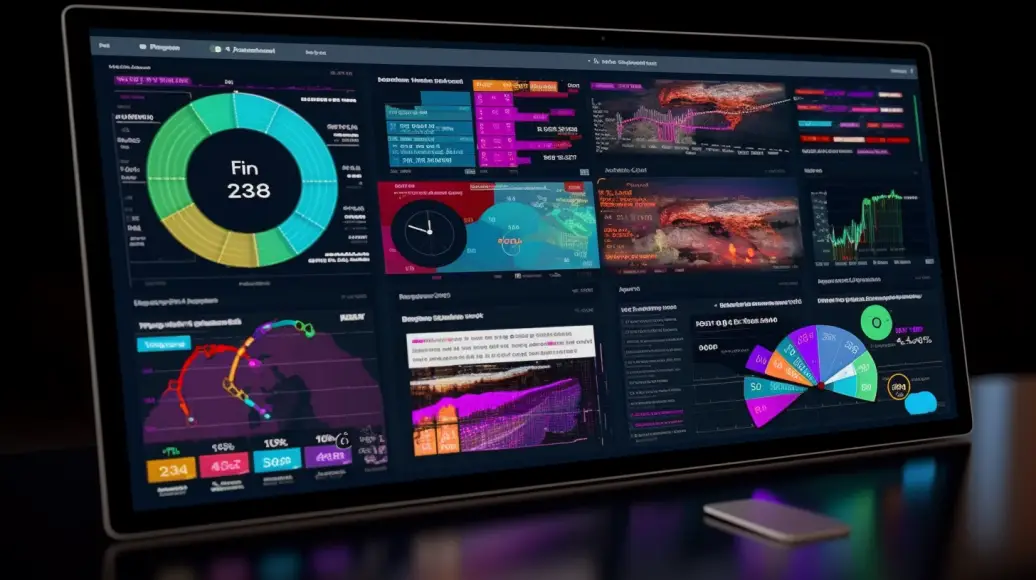Enterprise Risk Management (ERM) is a strategic business discipline that supports the achievement of an organization’s objectives by addressing the full spectrum of its risks and managing the combined impact of those risks as an interrelated risk portfolio.
Key Risk Indicators (KRIs) in an ERM program provide an early signal of increasing risk exposures in various areas of the enterprise. Here are some examples:
Operational Risk: This could be represented by the number of failed internal processes, systems failures, or instances of regulatory non-compliance.
Financial Risk: This could be indicated by liquidity ratios, debt ratios, or significant variances in budgeted and actual figures.
Strategic Risk: This might be represented by changes in market share, customer satisfaction scores, or the successful execution of strategic initiatives.
Compliance Risk: This could be indicated by the number of non-compliance issues, fines, or penalties imposed by regulatory bodies.
Reputational Risk: This could be represented by negative press coverage, social media sentiment, or customer complaints.
Cybersecurity Risk: This might be indicated by the number of attempted cyber-attacks, successful breaches, or system downtime due to security incidents.
Human Capital Risk: This could be represented by employee turnover rates, employee satisfaction scores, or instances of workplace accidents or injuries.
Legal Risk: This could be indicated by ongoing lawsuits, legal complaints, or fines for non-compliance with laws and regulations.
These KRIs can provide a comprehensive view of the risk landscape within an organization and help in the early detection of potential issues. However, it’s important to note that KRIs should be tailored to each organization’s needs, objectives, and risk appetite.
This article will provide a comprehensive overview of KRIs and KPIs, how they can be used to improve decision-making and strategy execution, and how they can be monitored and measured.
We’ll also discuss the different types of indicators available and the six-step process for introducing them into an ERM program.

Overview and Benefits of Key risk indicators
As ERM managers, we understand that key risk indicators (KRIs) can be incorporated into enterprise risk management (ERM) programs to provide an early warning system that helps us anticipate when the corporate risk profile is changing.
KRIs are usually numerical and tracked against upper and/or lower tolerance bands to represent the metric’s expected range or the metric or the values of the metric that can be “tolerated” by the organization without a material change in risk levels or a serious threat to objectives.
In addition, KRIs and KPIs can be used to measure and collect data that can be used for improved decision-making and strategy execution. This data can also be used to measure prediction accuracy and to develop baselines that will be helpful in future planning and decision-making.
Many ERM programs can benefit from using indicators easily and practically, and software tools can help considerably by providing automation, built-in guidance, and analysis expertise.
Using KRIs and KPIs in ERM programs can benefit from improving the likelihood of desired business outcomes to identifying potential risks and opportunities associated with sustainability initiatives.
This helps us identify better, consider our strategic assumptions more carefully, and create an effective early warning system.
Types of Indicators for ERM Program
You can use indicators to monitor potential risks and performance in your ERM program, so don’t miss out on their value. Key Risk Indicators (KRIs) and Key Performance Indicators (KPIs) are important metrics that can be utilized to measure the effectiveness of an ERM program.
KRIs are activities or outcomes that signal to a risk manager that a risk event is becoming more or less likely, while KPIs measure performance metrics related to specific objectives.
A variety of indicators can be used in an ERM program, such as those related to financial performance, customer satisfaction, employee engagement, and resource utilization. Other indicators may be related to specific risks, such as cybersecurity, safety, and compliance.
Indicators can also measure the effectiveness of risk management activities, such as risk assessments, mitigation strategies, and monitoring activities. Software tools can help simplify the process of creating and measuring indicators, providing automation along with built-in guidance and analysis expertise.
For example, risk reporting software can provide multiple reports to identify gaps in assessments, mitigation, control activities, and monitoring/testing activities.
Additionally, ESG software can help identify potential risks and opportunities associated with sustainability initiatives, and LogicManager enables reports to be filtered by assessment cut level for process improvement.
Automation is key to staying on top of the growing volume of data that must be monitored in ERM programs.
Indicators are an invaluable tool for ERM programs. They can provide an early warning system that allows risk managers to identify changes in the corporate risk profile, measure prediction accuracy, and develop baselines for future planning.
Automation can help simplify the process and ensure that KRIs and KPIs are used effectively. Additionally, measuring indicators can lead to better decision-making and strategy execution and help ensure that key risks are monitored and managed appropriately.
Adding to ERM
Adding indicators can help us avoid potential risks and ensure our objectives are met. Incorporating indicators into our ERM program is a straightforward process when done correctly. Below is a summary of steps that can be taken to quickly and easily add KRIs and KPIs to the program.
| Step | Description |
|---|---|
| 1 | Identify indicators that are relevant to your ERM program and objectives. |
| 2 | Establish upper and lower tolerance bands for each indicator. |
| 3 | Define the frequency of measurement. |
| 4 | Collect and analyze data. |
| 5 | Report results. |
Once the indicators have been established, it is important to monitor them regularly and ensure they accurately reflect the risk environment. This can be done by regularly reviewing the data and taking corrective action when necessary.
Additionally, the indicators should be incorporated into the planning process to ensure the risk environment is considered when developing and executing strategies.
ERM Metrics and KRIs
Risk managers use metrics and KRIs to measure the effectiveness of their risk management program. They can monitor the success of the program, identify trends, and assess the impact of the risk management activities. KRIs can be used to track the program’s progress and can be escalated to boards and CEOs.
Risk reporting software provides multiple reports to identify gaps in assessments, mitigation, control activities, and monitoring/testing activities. LogicManager enables reports to be filtered by assessment cut level for process improvement.
The total number of systemic risks identified is a crucial metric for risk management, as is the percentage of process areas involved in risk assessments. The percentage of key risks monitored and mitigated helps prioritize activities and resources.
Risk impact is often measured by factoring in threats to the company’s security, finances, reputation, safety, or operations and is usually made on a 1-10 scale.
KRIs are essential in monitoring risk and staying on top of compliance requirements. Tracking KRIs ensures that critical risks are constantly monitored and that any changes in the corporate risk profile are quickly identified and addressed.
ThesKris offers a complimentary download of risk reporting dashboard examples, which visually represent the risk profile and the performance of the risk management program.
It also provides a frequently asked questions section to help organizations understand the importance of measuring risk management metrics and KRIs for boards, CEOs, and the public.
Cross-functional ERM and consistent risk assessments are essential for prioritizing activities and resources. The text suggests a standardized way to express the severity of impact in quantitative and qualitative terms.
In the era of a transparent economy, the public can also impact a company’s reputation. The articles provide valuable information for risk managers looking to incorporate KRIs and KPIs into their ERM programs.
ESG software can help identify potential risks and opportunities associated with sustainability initiatives. Spreadsheets don’t lead to improving the likelihood of desired business outcomes, so software tools can help considerably by providing automation, along with built-in guidance and analysis expertise.

Monitoring ERM program Key risk indicators
We understand that monitoring your ERM program’s key risk indicators (KRIs) is essential for quickly identifying and addressing any changes in the corporate risk profile.
KRIs are activities or outcomes that signal to a risk manager that a particular risk event is becoming more or less likely. These indicators help ERM programs transform from static repositories into dynamic systems that monitor risk and performance.
Here are four key points to consider when monitoring ERM program KRIs:
- Measuring and collecting indicator data will generate valuable information to measure prediction accuracy and develop baselines that will be helpful in future planning and decision-making.
- Kris doesn’t necessarily need to be causally related to being useful. They can be used for improved decision-making and strategy execution.
- Software tools can help automate KRI monitoring and provide built-in guidance and analysis expertise.
- Rising KRIs provide an early warning system that lets ERM managers know when the corporate risk profile changes.
ERM programs can quickly identify and address changes in the corporate risk profile. These indicators can provide valuable insight into potential risks, helping organizations stay on top of compliance requirements and prioritize activities and resources.
Frequently Asked Questions
How do I know which indicators to use for my ERM program?
We need to research and analyze the different types of indicators to determine which are most suitable for our ERM program. We should then measure and collect indicator data to measure prediction accuracy and develop baselines.
How often should I review my KRIs and KPIs?
We should review our KRIs and KPIs regularly to ensure our ERM program is up-to-date and effective. The frequency will depend on the risk environment, but quarterly is recommended.
What are the risks associated with relying solely on indicators to measure risk?
Relying solely on indicators to measure risk can overlook important underlying factors contributing to changing risk profiles. We must ensure our ERM program considers all potential risks, not just those indicated by indicators.
How can I ensure that my KRIs are accurate and up to date?
We can ensure our KRIs are accurate and up to date by regularly monitoring them, researching trends, and analyzing data to detect changes in risk levels.
What other tools can I use to supplement my ERM program’s KRIs?
We can supplement our ERM program’s KRIs with software tools to help automate the process, provide built-in guidance, and analyze data. This will enable us to measure prediction accuracy, develop baselines, and make better decisions.

Conclusion
We’ve seen the numerous benefits of incorporating KRIs and KPIs into ERM programs. Key Risk And Performance Indicators are essential to a successful ERM program. They improve decision-making and strategy execution and monitor and measure risk and performance.
With various indicators available, selecting the right ones for your program is important. By understanding the six-step process for introducing these into your ERM program, you can ensure that your program is set up for success.
With the right KRIs and KPIs in place, you can be sure that your ERM program is well-equipped to tackle the risks and opportunities of the changing business environment.

Chris Ekai is a Risk Management expert with over 10 years of experience in the field. He has a Master’s(MSc) degree in Risk Management from University of Portsmouth and is a CPA and Finance professional. He currently works as a Content Manager at Risk Publishing, writing about Enterprise Risk Management, Business Continuity Management and Project Management.

